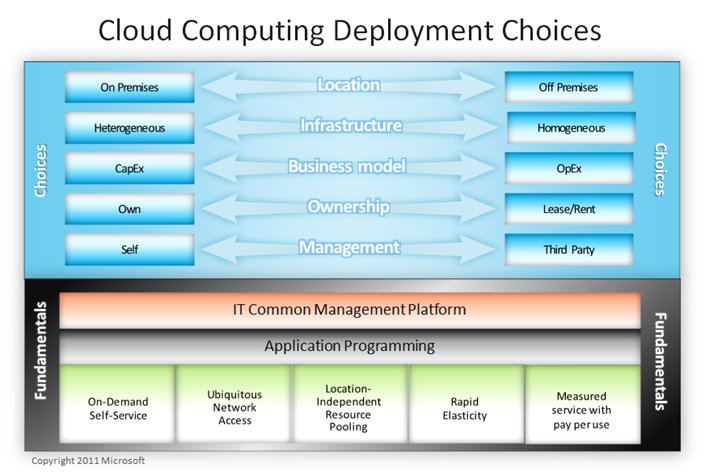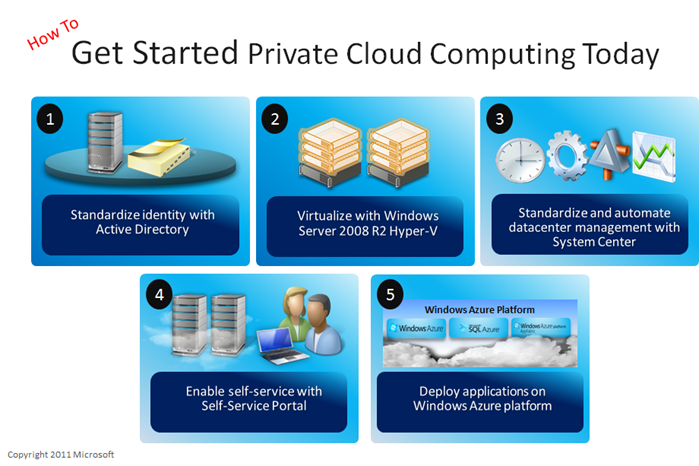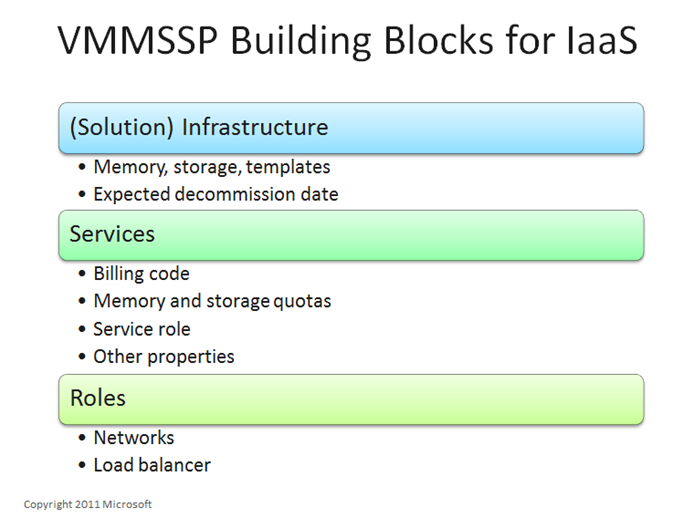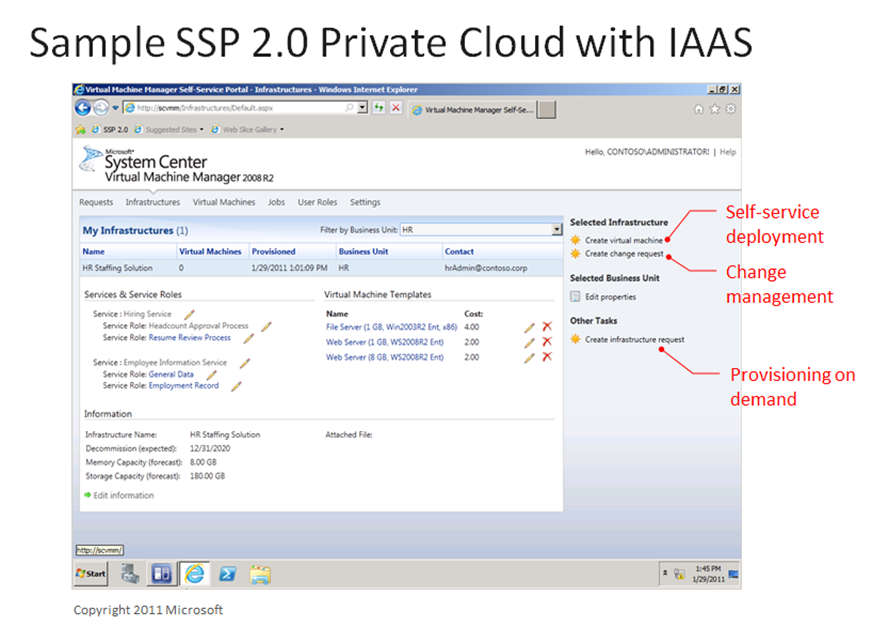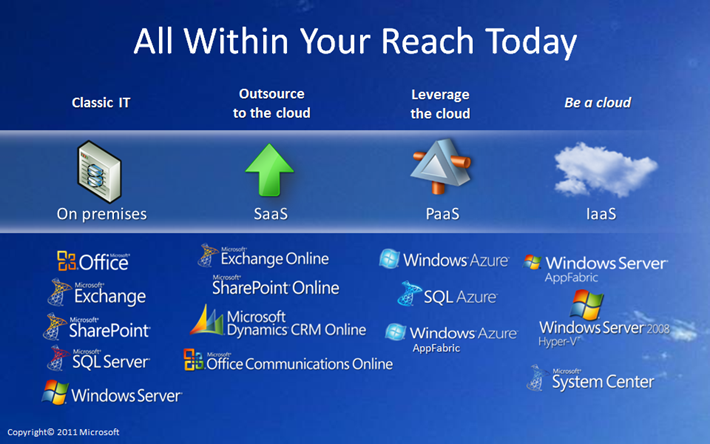Cloud Computing for IT Pros (6/6): Building Private Cloud of IaaS
Technorati Tags: service,cloud,azure,fabric,saas,paas,iaas
This series focusing on cloud essentials for IT professionals includes:
- Part 1: What Is Service
- Part 2: What Is Cloud
- Part 3: Windows Azure Computing Model
- Part 4: Fabric Controller and AppFabric
- Part 5: Publishing Windows Azure Application to Public Cloud
- Part 6: Building Private Cloud of IaaS
Power of Choices
For enterprise, cloud computing presents tremendous opportunities to re-architect IT for the future. From infrastructure to business model and management, as depicted in the following, IT now has options to redistribute, reorganize, reset priorities which perhaps not feasible in a traditional on-premises only computing model. IT can shift the cost from capital expense to operational, let a 3rd party to run those functions not in the core business, employ cloud to easily scale up or out, etc. And the benefits of having a dedicated cloud are apparent and attractive. And that is the so-called private cloud, a dedicated cloud which can be run on premises or hosted off premises by a 3rd party.
Essence of Cloud
How to deploy and where to deploy a service do require strategic planning and solid fundamentals in application architecture, such that the benefits of cloud computing can be realized in a timely and predictable fashion. There are specific capabilities that cloud computing is expected to provide. Essentially, regardless how cloud computing is deployed or delivered, applications need to engineer in the quality and exhibit the five characteristics of cloud computing, namely:
- On-demand, self-service
- Ubiquitous network access
- Resource pooling with location trenchancy
- Rapid elasticity
- Measured service with pay per use
Else, one can call it whatever one wants. It is however not the cloud computing that IT industry is talking about.
Approaching Private Cloud
Depending on the priorities of a business, the above 5 characteristics may not be all relevant for building private cloud. For instance, perhaps ubiquitous network access is not required since in a private cloud setting IT may not want resources to be that accessible for security reasons. Corporate may not critically need a pay per use model due to the complexity and feasibility to implement chargeback. To approach private cloud, there needs an overall vision to define the goals for the next three to five years. Private cloud is expensive and mechanism to ensure predictable results must be put in place. Enterprise IT needs to enforce hardware/software standards in datacenter and automate/optimize operations and procedures, when possible. Application architect need to develop cloud application design guidelines to ensure application manageability and readiness for running in a mixed (i.e. cloud and on-premises) environment. On top of applications, a common platform to manage physical, virtualized, and cloud resources transparently and in a consistent fashion is strategic and imperative to transition into cloud computing. Without a unified way to manage not only virtual machines, but the workloads; without a single pane of glass to manage the applications within private cloud, but public cloud as well, the cloud transformation will introduce many manageability issues into IT operations, and the process is likely to become divergent, with run-away costs, and eventually non-manageable.
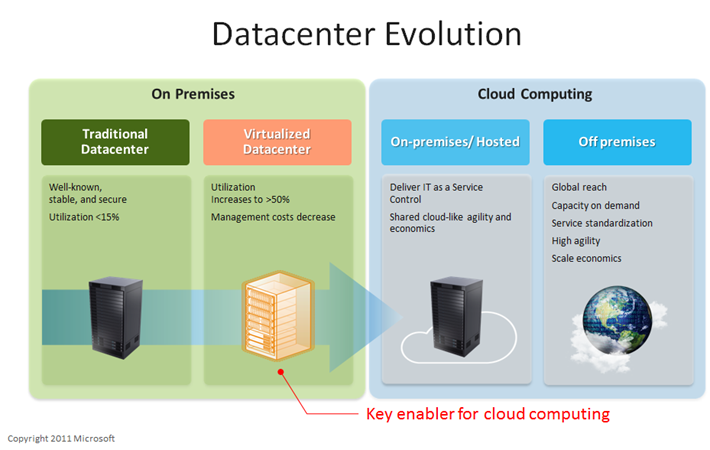
For transforming into cloud computing, there are developed strategies. The above shows a logical progression from an on-premises establishment towards off-premises cloud computing. Along the process, virtualization is taking place and will continue the momentum. (Gartner Symposium ITexpo 2010) This is because for cloud computing to be a reality, virtualization is essential in current technology. Virtualization also implies that a management solution needs to be in place. For cloud to scale rapidly with pooled resources with location transparency, virtual machines and the ability to manage the physical hardware, virtual machines and workloads running within are essential. The management solution will need to know which virtual machines need attentions, how to operate them, where to place them, and what to do with them. Further the ability to monitor and manage the applications/services running within a workload is as critical since it is the applications/services that we care and not the virtual machines themselves. Once virtualization are introduced and mature, enterprise IT can then migrate into an on-premises private cloud before moving into running datacenter in public cloud, if that is the goal. Depending on the business needs, I imagine many IT shops will settle somewhere among virtualized, private cloud, and public cloud. I believe to cloud or not to cloud, that is not the question. The question is really how much and how far.
Specific to private cloud, the above specifies the key milestones, essential capabilities, and recommendations. Each is crucial for contributing a predictable ROI with cost-effectiveness in the long run. Enterprise IT must rethink how to conduct business, develop a vision with a roadmap to move from structured responses to on-demand deliveries. And private cloud is the very opportunity.
Do-It-Yourself Private Cloud
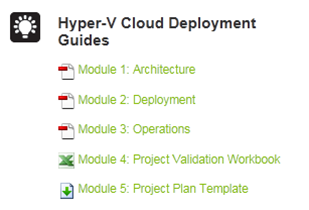 The private cloud solutions from Microsoft is collectively called Hyper-V Cloud which is a set of guidelines and offerings, and not a packaged product. Hyper-V Cloud offerings is mainly for building private cloud of IaaS as of February of 2011. Fast Track is delivered by partners having worked with Microsoft to combine hardware and software offerings based on a reference architecture for building private clouds. There is also a Service Provider Program to identify a qualified service provider to host a dedicated private cloud for you. Above all, there is Hyper-V Deployment Guide for you to build your own private cloud. Yes, you can do it yourself to build a private cloud. In fact regardless which option you plan to acquire your private cloud, I highly recommend going through the Deployment Guide and building a private cloud yourself in a lab environment to get a much better understanding on how to architect, implement, and manage a cloud computing solution.
The private cloud solutions from Microsoft is collectively called Hyper-V Cloud which is a set of guidelines and offerings, and not a packaged product. Hyper-V Cloud offerings is mainly for building private cloud of IaaS as of February of 2011. Fast Track is delivered by partners having worked with Microsoft to combine hardware and software offerings based on a reference architecture for building private clouds. There is also a Service Provider Program to identify a qualified service provider to host a dedicated private cloud for you. Above all, there is Hyper-V Deployment Guide for you to build your own private cloud. Yes, you can do it yourself to build a private cloud. In fact regardless which option you plan to acquire your private cloud, I highly recommend going through the Deployment Guide and building a private cloud yourself in a lab environment to get a much better understanding on how to architect, implement, and manage a cloud computing solution.
Getting Ready for the Changes
For IT pros, cloud is a leap from administering server boxes to managing services. The abstraction layer placed by virtualization makes it a lesser concern of the physical hardware in most cloud computing scenarios. This is hard and a cultural shock for most IT pros. With the continual advancement of virtualization technologies, the changing perspective of IT infrastructure is inevitable. One obvious example is that Microsoft System Center Virtual Machine Manager (VMM) Self-Service Portal (SSP) 2.0 introduces a service-centric view of implementing private cloud of IaaS. SSP 2.0 uses (Solution) Infrastructure, Services, and Roles as the building blocks as shown below. A private cloud of IaaS user will then form a service delivery model with a hierarchy where an Infrastructure consists of Services, while each Service includes Roles, and virtual machines are deployed based on the defined Roles.
While integrated with VMM, SSP 2.0 is a free offering from Microsoft that includes a set of web portals, a data store, a lightweight provisioning engine, and documentation and guidance. Within SSP 2.0, a datacenter administrator will first define the resource pools of network, commuting (RAM), and storage (disk space) resources and the cost model of reserving and allocating these resources. There are also predefined templates for deploying virtual machines to be imported from VMM into SSP 2.0 as datacenter’s resources. An authorized business unit administrator will then register one’s business unit followed by making a request for creating a Solution Infrastructure and the included Services and Roles. Once a request is approved by datacenter admin, an authorized user can deploy virtual machines on demand based on approved computing and storage quota. The cost of reserving and deploying an Infrastructure is calculated according to a chargeback model.
The following is a sample solution infrastructure for a Staffing solution. The hiring service is to post job opening, accept resumes, and run through the interview process. Once a candidate is hired as an employee, HR will create a record with Employee Information service and establish employment history and confidential records, while the employee can use the same service to maintain the personal data like home address, phone numbers, etc. The significance of doing this in private cloud is that once the cloud is defined, it is centrally managed with self-serving, on-demand, workflows, and chargeback capabilities. The system is monitored and managed by VMM. On a regular basis, usage IT can now generate reports to conclude the amount to charge back to business units based on their usage.
The provisioning and deploying of a so-called Infrastructure here are quite different than traditional way deploying servers in an on-premises computing environment. Because the deployment is carried out with virtual machines, the computing and storage requirements can be and are provisioned on demand by changing the specifications of a change request. Once approved by datacenter admin via workflow, SSP 2.0 will then allow an authorized user to allocate resources within permitted quota. An authorized user can create/deploy virtual machines on demand as shown in the following. The construction of an “infrastructure” is now much more focused on designing and deploying the “service” with requested capacity and not so much on the involved physical hardware and topology. This allows IT to focus more on enabling business and not constantly running cables and setting up servers. This is called Infrastructure as a Service with private cloud in action.
Start Now
Personally what gets me most excited about cloud is that all I have discussed are within the reach today. Either to consume, build, or be a cloud, there are so many opportunities to improve IT service deliveries and offer a better experience to users, and grow professionally at the same time. Changes are happening and coming strong. I however see this time they are exciting and for the better. Start immediately. Start now to accept the changes, master the changes, and win all the changes.
So let it be known. I am an IT pro and private cloud was my idea. 
